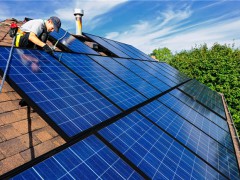據(jù)今日油價(jià)網(wǎng) 4月14日?qǐng)?bào)道,美國(guó)能源信息署(EIA)周四表示,3月29日,風(fēng)力渦輪機(jī)發(fā)電成為美國(guó)第二大電力來源,僅次于天然氣,是有記錄以來首次超過煤炭和核能發(fā)電。
EIA的小時(shí)電網(wǎng)監(jiān)測(cè)顯示,3月29日,美國(guó)本土48個(gè)州的風(fēng)力渦輪機(jī)發(fā)電量為2017億瓦時(shí)(GWh)。該機(jī)構(gòu)指出,今年早些時(shí)候,每天的風(fēng)力發(fā)電分別超過了燃煤發(fā)電和核能發(fā)電,但沒有在一天內(nèi)同時(shí)超過這兩個(gè)來源。
近年來,美國(guó)風(fēng)電裝機(jī)容量飆升,2019年9月,風(fēng)電裝機(jī)容量超過了核電裝機(jī)容量。
EIA稱,目前,風(fēng)力發(fā)電是美國(guó)第三大發(fā)電來源,排在天然氣發(fā)電機(jī)和燃煤發(fā)電機(jī)之后。
盡管風(fēng)力發(fā)電能力在兩年前就超過了核能,但風(fēng)力發(fā)電的發(fā)電量仍低于核能發(fā)電,因?yàn)檫@兩種技術(shù)的利用方式不同。
2021年,美國(guó)風(fēng)力發(fā)電機(jī)的平均容量系數(shù)為35%,遠(yuǎn)低于核能發(fā)電機(jī)的平均容量系數(shù)93%。核發(fā)電機(jī)通常被設(shè)計(jì)成以全功率或接近全功率運(yùn)行。
美國(guó)能源情報(bào)署(EIA)最新的短期能源展望預(yù)測(cè)顯示,盡管風(fēng)力發(fā)電量在某一天超過了煤炭和核能,但預(yù)計(jì)今年或明年的任何一個(gè)月,風(fēng)力發(fā)電量都不會(huì)超過煤炭或核能。
美國(guó)清潔能源協(xié)會(huì)(ACP)今年2月表示,2021年,美國(guó)運(yùn)營(yíng)的公用事業(yè)規(guī)模的清潔電力總?cè)萘砍^了200兆瓦,但同時(shí)也警告稱,“重大的政策問題繼續(xù)阻礙該行業(yè)的增長(zhǎng),并威脅到國(guó)家實(shí)現(xiàn)排放目標(biāo)的能力。”
由于供應(yīng)鏈問題和市場(chǎng)波動(dòng),今年風(fēng)力發(fā)電裝機(jī)容量的增長(zhǎng)可能會(huì)放緩。
季廷偉 摘譯自 今日油價(jià)網(wǎng)
原文如下:
U.S. Wind Surpassed Both Coal And Nuclear Power For The First Time Ever
Power generation from wind turbines was the second-largest source of electricity in the United States on March 29, behind only natural gas and surpassing both coal and nuclear power generation for the first time on record, the U.S. Energy Information Administration (EIA) said on Thursday.
On March 29, wind turbines in the Lower 48 states produced 2,017 gigawatt-hours (GWh) of electricity, EIA’s Hourly Electric Grid Monitor showed. Daily wind-powered electricity had surpassed coal-fired and nuclear electricity generation separately on other days earlier this year but had not surpassed both sources on a single day, the administration noted.
The U.S. wind power capacity installation has soared in recent years to the point where wind capacity exceeded nuclear capacity in September 2019.
Currently, wind power ranks as the third-largest source of generating capacity in the United States, behind natural gas-fired generators and coal-fired generators, the EIA said.
Despite surpassing nuclear capacity more than two years ago, wind still generated less electricity than nuclear because the two technologies differ in their utilization.
The average capacity factor of U.S. wind generators was 35 percent in 2021, much lower than the average capacity factor of nuclear generators, 93 percent in 2021. Nuclear generators are designed to run at or near full output, which they typically do.
Despite beating both coal and nuclear on a single day, wind power generation in the U.S. is not expected to surpass either coal or nuclear generation on a monthly basis in any month this year or next, the EIA’s most recent Short-Term Energy Outlook forecast showed.
The U.S. surpassed more than 200 GW of total operating utility-scale clean power capacity in 2021, the American Clean Power Association (ACP) said in February, but warned that “significant policy issues continue to hold back growth for the industry and threaten the country’s ability to meet emissions goals.”
Growth in wind power installations could slow this year due to ongoing supply chain issues.
免責(zé)聲明:本網(wǎng)轉(zhuǎn)載自其它媒體的文章及圖片,目的在于弘揚(yáng)石化精神,傳遞更多石化信息,宣傳國(guó)家石化產(chǎn)業(yè)政策,展示國(guó)家石化產(chǎn)業(yè)形象,參與國(guó)際石化產(chǎn)業(yè)輿論競(jìng)爭(zhēng),提高國(guó)際石化產(chǎn)業(yè)話語權(quán),并不代表本網(wǎng)贊同其觀點(diǎn)和對(duì)其真實(shí)性負(fù)責(zé),在此我們謹(jǐn)向原作者和原媒體致以崇高敬意。如果您認(rèn)為本站文章及圖片侵犯了您的版權(quán),請(qǐng)與我們聯(lián)系,我們將第一時(shí)間刪除。







